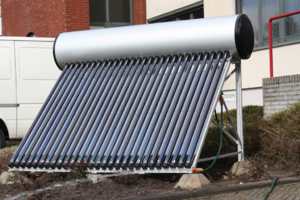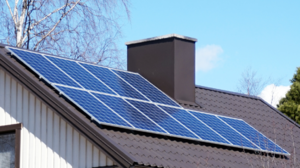Difference between revisions of "Solar Power"
(Created page with "==Key Stage 3== ===Meaning=== '''Solar''' is an energy resource that uses the energy transferred to the Earth from the Sun by [...") |
|||
| (10 intermediate revisions by 2 users not shown) | |||
| Line 1: | Line 1: | ||
==Key Stage 3== | ==Key Stage 3== | ||
===Meaning=== | ===Meaning=== | ||
| − | '''Solar''' is an [[Energy Resource|energy resource]] that uses the [[Energy Transfer|energy transferred]] to the [[Earth]] from | + | '''Solar Power''' is an [[Energy Resource|energy resource]] that uses the [[Energy Transfer|energy transferred]] to the [[Earth]] from [[The Sun]] by [[light]] and [[Thermal Radiation|thermal radiation]]. |
===About Solar=== | ===About Solar=== | ||
| − | : [[Solar]] is a [[Renewable Energy Resource|renewable energy resource]]. | + | : [[Solar Power]] is a [[Renewable Energy Resource|renewable energy resource]]. |
| − | : [[Solar]] has uses [[energy]] in the [[Thermal Energy Store|thermal energy store]] of | + | : [[Solar Power]] has uses [[energy]] in the [[Thermal Energy Store|thermal energy store]] of [[The Sun]] which has been transferred to the [[Earth]] by [[Radiation]]. |
===Power=== | ===Power=== | ||
| − | [[Solar]] can be used to provide hot water or generate electricity. | + | [[Solar Power]] can be used to provide hot water or generate electricity. |
{| class="wikitable" | {| class="wikitable" | ||
|- | |- | ||
|[[File:SolarWaterHeater.png|center|300px]] | |[[File:SolarWaterHeater.png|center|300px]] | ||
| − | |[[File: | + | |[[File:SolarCells.png|center|300px]] |
|- | |- | ||
| − | | style="height:20px; width:300px; text-align:center;" |Water is passed through black tubes which [[Absorb (Physics)|absorb]] [[Thermal Radiation|thermal radiation]] from | + | | style="height:20px; width:300px; text-align:center;" |Water is passed through black tubes which [[Absorb (Physics)|absorb]] [[Thermal Radiation|thermal radiation]] from [[The Sun]] to [[heat]] the water. |
| − | | style="height:20px; width:300px; text-align:center;" |Light is [[Absorb (Physics)|absorbed]] providing [[energy]] to | + | | style="height:20px; width:300px; text-align:center;" |Light is [[Absorb (Physics)|absorbed]] providing [[energy]] to produce an [[Electrical Current|electrical current]]. |
|} | |} | ||
| + | |||
| + | ====Advantages of Solar Cells==== | ||
| + | *Can provide power in places not connected to the national grid. | ||
| + | *Do not produce pollution. | ||
| + | *The running cost is almost nothing. | ||
| + | *No fuel cost. | ||
| + | |||
| + | ====Disadvantages of Solar Cells==== | ||
| + | *Expensive to build. | ||
| + | *Large areas must be covered in cells in order to produce enough electrical power. | ||
| + | *Only work when it’s sunny (not during the night time and slightly less in cloudy weather). | ||
| + | *Cannot increase power output when more is needed. | ||
| + | |||
| + | ==Key Stage 4== | ||
| + | {{#ev:youtube|https://www.youtube.com/watch?v=wiGsba8wVSk}} | ||
| + | ===Meaning=== | ||
| + | '''Solar''' is an [[Energy Resource|energy resource]] that uses the [[Energy Transfer|energy transferred]] to the [[Earth]] from [[The Sun]] by [[light]] and [[Thermal Radiation|thermal radiation]]. | ||
| + | |||
| + | ===About Solar=== | ||
| + | : [[Solar Power]] is a [[Renewable Energy Resource|renewable energy resource]]. | ||
| + | : [[Solar Power]] has uses [[energy]] in the [[Thermal Energy Store|thermal energy store]] of [[The Sun]] which has been transferred to the [[Earth]] by [[Radiation]]. | ||
| + | |||
| + | ===Power=== | ||
| + | [[Solar Power]] can be used to provide hot water or generate electricity. | ||
| + | {| class="wikitable" | ||
| + | |- | ||
| + | |[[File:SolarWaterHeater.png|center|300px]] | ||
| + | |[[File:SolarCells.png|center|300px]] | ||
| + | |- | ||
| + | | style="height:20px; width:300px; text-align:center;" |Water is passed through black tubes which [[Absorb (Physics)|absorb]] [[Thermal Radiation|thermal radiation]] from [[The Sun]] to [[heat]] the water. | ||
| + | | style="height:20px; width:300px; text-align:center;" |Light is [[Absorb (Physics)|absorbed]] providing [[energy]] to produce an [[Electrical Current|electrical current]]. | ||
| + | |} | ||
| + | |||
| + | ====Advantages of Solar Cells==== | ||
| + | *Can provide power in places not connected to the national grid. | ||
| + | *Do not produce pollution. | ||
| + | *The running cost is almost nothing. | ||
| + | *No fuel cost. | ||
| + | |||
| + | ====Disadvantages of Solar Cells==== | ||
| + | *Expensive to build. | ||
| + | *Large areas must be covered in cells in order to produce enough electrical power. | ||
| + | *Only work when it’s sunny (not during the night time and slightly less in cloudy weather). | ||
| + | *Cannot increase power output when more is needed. | ||
| + | |||
| + | ===References=== | ||
| + | ====AQA==== | ||
| + | |||
| + | :[https://www.amazon.co.uk/gp/product/1782945598/ref=as_li_tl?ie=UTF8&camp=1634&creative=6738&creativeASIN=1782945598&linkCode=as2&tag=nrjc-21&linkId=ad276ad49df77ab4b40ab4fd0fe10289 ''Solar power, page 176, GCSE Combined Science; The Revision Guide, CGP, AQA ''] | ||
| + | :[https://www.amazon.co.uk/gp/product/1471851370/ref=as_li_tl?ie=UTF8&camp=1634&creative=6738&creativeASIN=1471851370&linkCode=as2&tag=nrjc-21&linkId=01c69b0ae058f809cf636033e6ba793e ''Solar power, page 25, GCSE Physics, Hodder, AQA ''] | ||
| + | :[https://www.amazon.co.uk/gp/product/1471851354/ref=as_li_tl?ie=UTF8&camp=1634&creative=6738&creativeASIN=1471851354&linkCode=as2&tag=nrjc-21&linkId=9012a0d354024419214fb3ad5ac44ba0 ''Solar power, page 280, GCSE Combined Science Trilogy 1, Hodder, AQA ''] | ||
| + | :[https://www.amazon.co.uk/gp/product/178294558X/ref=as_li_tl?ie=UTF8&camp=1634&creative=6738&creativeASIN=178294558X&linkCode=as2&tag=nrjc-21&linkId=f0dfb66dafcb0c6e9449e7b1a4ae1ac411 ''Solar power, pages 19, 22, GCSE Physics; The Revision Guide, CGP, AQA ''] | ||
| + | :[https://www.amazon.co.uk/gp/product/019835939X/ref=as_li_tl?ie=UTF8&camp=1634&creative=6738&creativeASIN=019835939X&linkCode=as2&tag=nrjc-21&linkId=57e96876985fc39b1a3d8a3e3dc238b6 ''Solar power, pages 33,40, GCSE Physics; Third Edition, Oxford University Press, AQA ''] | ||
| + | :[https://www.amazon.co.uk/gp/product/1782946403/ref=as_li_tl?ie=UTF8&camp=1634&creative=6738&creativeASIN=1782946403&linkCode=as2&tag=nrjc-21&linkId=32a0abb60dff015b15b50e9b1d7b4644 ''Solar power, pages 46-48, GCSE Combined Science Trilogy; Physics, CGP, AQA ''] | ||
| + | :[https://www.amazon.co.uk/gp/product/1782945970/ref=as_li_tl?ie=UTF8&camp=1634&creative=6738&creativeASIN=1782945970&linkCode=as2&tag=nrjc-21&linkId=a120d24dcc7cc7a58192069a3aafc1d2 ''Solar power, pages 48-50, GCSE Physics; The Complete 9-1 Course for AQA, CGP, AQA ''] | ||
| + | |||
| + | ====Edexcel==== | ||
| + | |||
| + | :[https://www.amazon.co.uk/gp/product/1782945741/ref=as_li_tl?ie=UTF8&camp=1634&creative=6738&creativeASIN=1782945741&linkCode=as2&tag=nrjc-21&linkId=30da4f2178da182547b62a7329d13b57 ''Solar power, page 161, GCSE Combined Science; The Revision Guide, CGP, Edexcel ''] | ||
| + | :[https://www.amazon.co.uk/gp/product/1782945733/ref=as_li_tl?ie=UTF8&camp=1634&creative=6738&creativeASIN=1782945733&linkCode=as2&tag=nrjc-21&linkId=2a2dbec9db6bf5766c0458d908fa0a52 ''Solar power, page 29, GCSE Physics; The Revision Guide, CGP, Edexcel ''] | ||
| + | |||
| + | ====OCR==== | ||
| + | :[https://www.amazon.co.uk/gp/product/1782945695/ref=as_li_tl?ie=UTF8&camp=1634&creative=6738&creativeASIN=1782945695&linkCode=as2&tag=nrjc-21&linkId=ceafcc80bcad6b6754ee97a0c7ceea53 ''Solar power, page 212, Gateway GCSE Combined Science; The Revision Guide, CGP, OCR ''] | ||
| + | :[https://www.amazon.co.uk/gp/product/1782945687/ref=as_li_tl?ie=UTF8&camp=1634&creative=6738&creativeASIN=1782945687&linkCode=as2&tag=nrjc-21&linkId=9a598e52189317a20311d7a632747bc9 ''Solar power, page 93, Gateway GCSE Physics; The Revision Guide, CGP, OCR ''] | ||
| + | :[https://www.amazon.co.uk/gp/product/0198359810/ref=as_li_tl?ie=UTF8&camp=1634&creative=6738&creativeASIN=0198359810&linkCode=as2&tag=nrjc-21&linkId=d768d99f1a06f7c12fab40e5aef85a55 ''Solar power, pages 2-3, Gateway GCSE Biology, Oxford, OCR ''] | ||
| + | :[https://www.amazon.co.uk/gp/product/0198359837/ref=as_li_tl?ie=UTF8&camp=1634&creative=6738&creativeASIN=0198359837&linkCode=as2&tag=nrjc-21&linkId=3c4229e8b023b2b60768e7ea2307cc6f ''Solar power, pages 2-3, Gateway GCSE Physics, Oxford, OCR ''] | ||
| + | |||
| + | ==Beyond the Curriculum== | ||
| + | {{#ev:youtube|https://www.youtube.com/watch?v=xKxrkht7CpY}} | ||
Latest revision as of 16:50, 19 December 2019
Key Stage 3
Meaning
Solar Power is an energy resource that uses the energy transferred to the Earth from The Sun by light and thermal radiation.
About Solar
- Solar Power is a renewable energy resource.
- Solar Power has uses energy in the thermal energy store of The Sun which has been transferred to the Earth by Radiation.
Power
Solar Power can be used to provide hot water or generate electricity.
| Water is passed through black tubes which absorb thermal radiation from The Sun to heat the water. | Light is absorbed providing energy to produce an electrical current. |
Advantages of Solar Cells
- Can provide power in places not connected to the national grid.
- Do not produce pollution.
- The running cost is almost nothing.
- No fuel cost.
Disadvantages of Solar Cells
- Expensive to build.
- Large areas must be covered in cells in order to produce enough electrical power.
- Only work when it’s sunny (not during the night time and slightly less in cloudy weather).
- Cannot increase power output when more is needed.
Key Stage 4
Meaning
Solar is an energy resource that uses the energy transferred to the Earth from The Sun by light and thermal radiation.
About Solar
- Solar Power is a renewable energy resource.
- Solar Power has uses energy in the thermal energy store of The Sun which has been transferred to the Earth by Radiation.
Power
Solar Power can be used to provide hot water or generate electricity.
| Water is passed through black tubes which absorb thermal radiation from The Sun to heat the water. | Light is absorbed providing energy to produce an electrical current. |
Advantages of Solar Cells
- Can provide power in places not connected to the national grid.
- Do not produce pollution.
- The running cost is almost nothing.
- No fuel cost.
Disadvantages of Solar Cells
- Expensive to build.
- Large areas must be covered in cells in order to produce enough electrical power.
- Only work when it’s sunny (not during the night time and slightly less in cloudy weather).
- Cannot increase power output when more is needed.
References
AQA
- Solar power, page 176, GCSE Combined Science; The Revision Guide, CGP, AQA
- Solar power, page 25, GCSE Physics, Hodder, AQA
- Solar power, page 280, GCSE Combined Science Trilogy 1, Hodder, AQA
- Solar power, pages 19, 22, GCSE Physics; The Revision Guide, CGP, AQA
- Solar power, pages 33,40, GCSE Physics; Third Edition, Oxford University Press, AQA
- Solar power, pages 46-48, GCSE Combined Science Trilogy; Physics, CGP, AQA
- Solar power, pages 48-50, GCSE Physics; The Complete 9-1 Course for AQA, CGP, AQA
Edexcel
- Solar power, page 161, GCSE Combined Science; The Revision Guide, CGP, Edexcel
- Solar power, page 29, GCSE Physics; The Revision Guide, CGP, Edexcel
OCR
- Solar power, page 212, Gateway GCSE Combined Science; The Revision Guide, CGP, OCR
- Solar power, page 93, Gateway GCSE Physics; The Revision Guide, CGP, OCR
- Solar power, pages 2-3, Gateway GCSE Biology, Oxford, OCR
- Solar power, pages 2-3, Gateway GCSE Physics, Oxford, OCR

